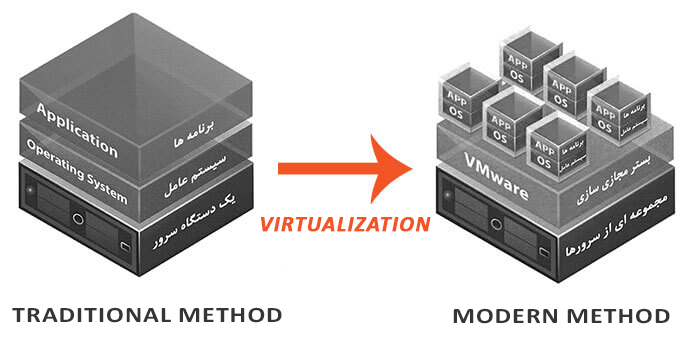Server Virtualization
Server virtualization means making software servers and operating systems independent from the hardware of a server, in other words, running a service or operating system on an intermediate platform.
benefits of virtual servers compared to the traditional structure:
- Reducing the cost of buying a hardware server for any operating system or server
- Isolating all kinds of services and servers on a hardware
- Optimum use of available server resources and cost reduction of power and cooling system
- unified management and systems flexibility
- Allocation of available resources including processor, memory, network card, and hard disk to each virtual machine as needed and changing it if necessary
- Reducing the amount of space occupied by servers
- Reducing Down Time in the network
- Eliminate hardware dependencies
- ….
virtual server
One of the new techniques in the labor market is the use of server virtualization. In fact, nowadays server virtualization is the main part of most data centers.
The reason for this can be due to the facilities that server virtualization provides to ICT managers of for better management.
server virtualization is the solution and method that causes several user operating systems to be placed on a hardware host at the same time.
server virtualization is the solution and method that causes several user operating systems to be placed on a hardware host at the same time.
Most of the virtualization work is done by a software and makes it possible to run an application on different hardwares that do not exist physically.
The reason to use server virtualization
During the past years, if you as an employee of an organization needed a server and ask for it, it was a long and time-consuming process.
Because there had to be a tender to buy the server and then the operating system was installed and launched on it and then delivered to you.
But nowadays, by using technology server-virtualization you can easily take it over in a short period of time, you can also remove the time period for installing the operating system with clone and template methods and capabilities, and in this case, it makes the period of taking over the server as well much shorter.
In the past, before the server virtualization technology development, departments and organizations used a specific hardware servers’ brand and related equipment and devices for their chores.
But today, with the server virtualization, you are freed from this choice and you can use the server in any way you want.
Because in terms of technology, hardware virtualization has always been one step behind the virtual methods of operating systems.
And alignment has been made at the operating system level and hyper visors, and this factor has increased the flexibility of data center and network managers and allows them to employ any kind of hardware. you can even easily move from one hardware to another with server virtualization.
Advantages of server virtualization
- Energy Conservation
- Reducing the amount of space in the data center
- Several people can share the server and increase productivity
- Saving the amount of space required for server locations
- Better network management and flexibility
- Increasing network capacity and flexibility
- Easier maintenance and support process
- growth and more efficiency of operational throughput by using virtual server
- Making systems more secure
- Reduce operational complexity
- Reducing the cost of purchasing hardware
Virtualization services
Raha Company provides services in the field of information technology such as consulting, monitoring, training, supply chain, implementation, troubleshooting, standardization and maintenance in the following cases:
In the areas of:
Virtualization
- (Server Virtualization)
- (Desktop Virtualization)
- (Network Virtualization)
- (Application Virtualization)
- (Storage Virtualization)
- 6. Installation and establishment of desktop virtualization infrastructure based on vCloudPoint zero client
Network monitoring
- SolarWinds network monitoring system
- PRTG network monitoring system
- MRTG network monitoring system
- Cacti network monitoring system
- Zabbix network monitoring system
- Nagios network monitoring system
Active computer networks
- Microsoft and Linux operating systems
- Workgroup-based networks
- Domain based networks
- Microsoft and Linux services
Passive network infrastructure
- passive
- Troubleshooting
- Preservation
- Optimization
- Standardization
Network Security
- ISO 27001:2005 audit
- penetration test
- Software and hardware firewalls
- Cisco security equipment
- Kerio Control system
- Surveillance cameras
Linux web application infrastructure
- LAMP optimization and security
Read free instruction in the field of virtualization, network, security, Linux and general in the training section of the website.




